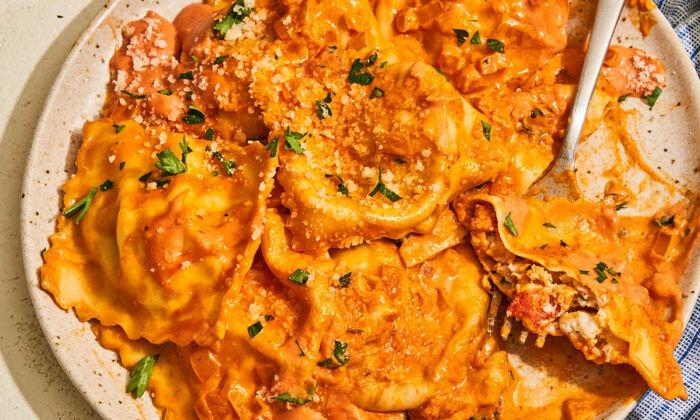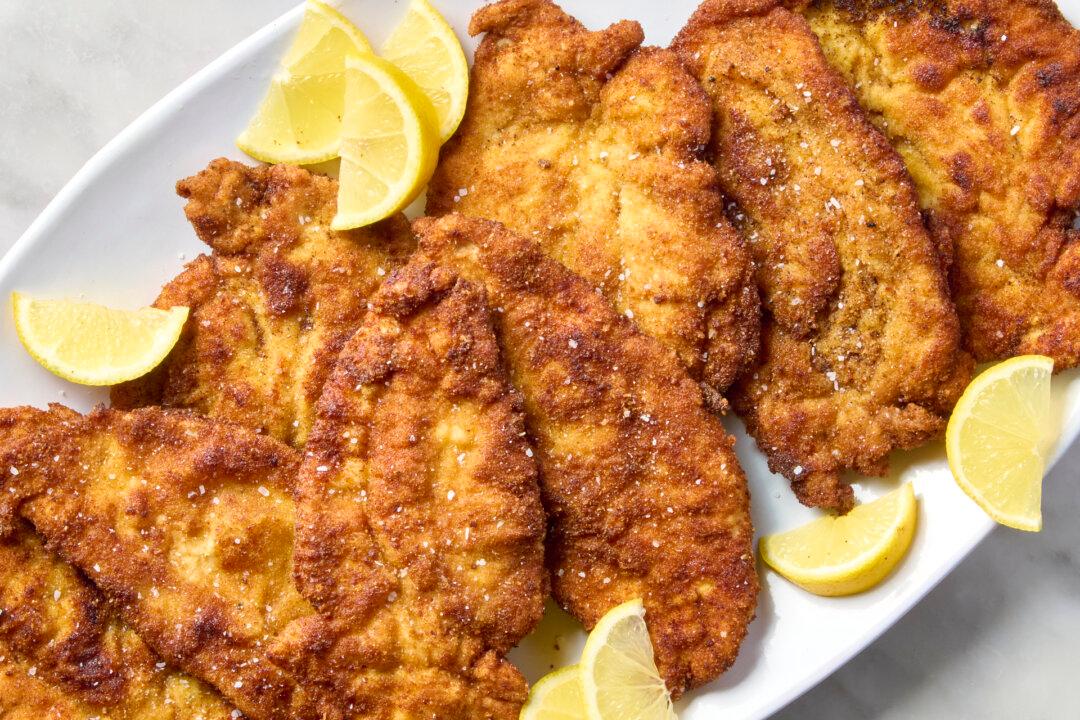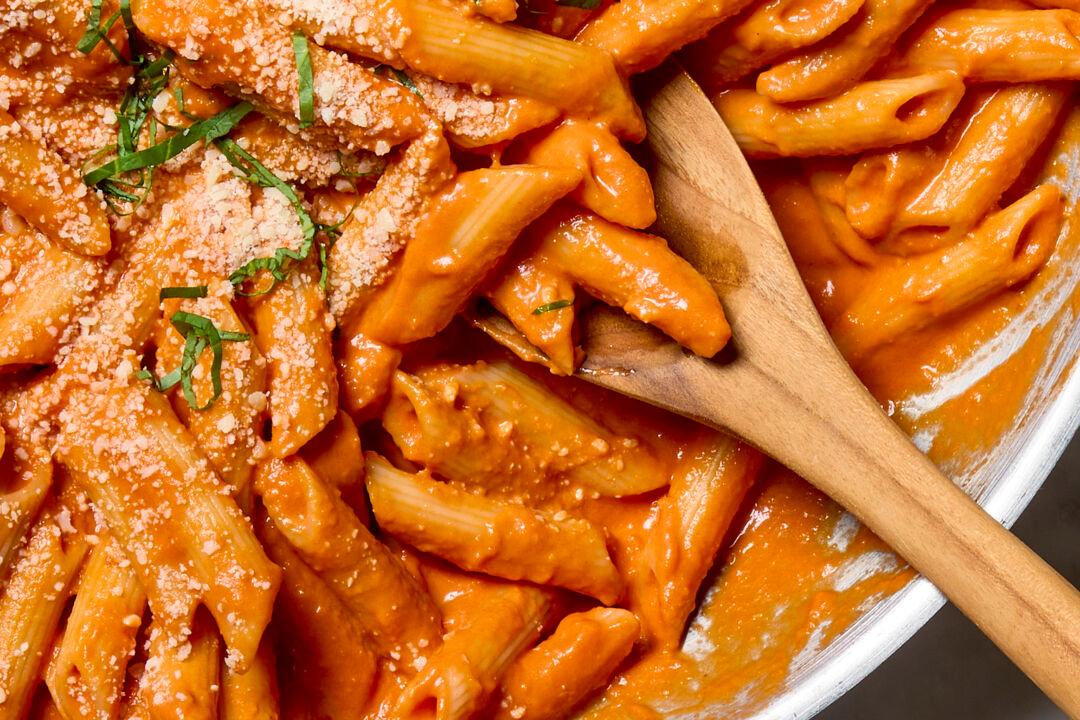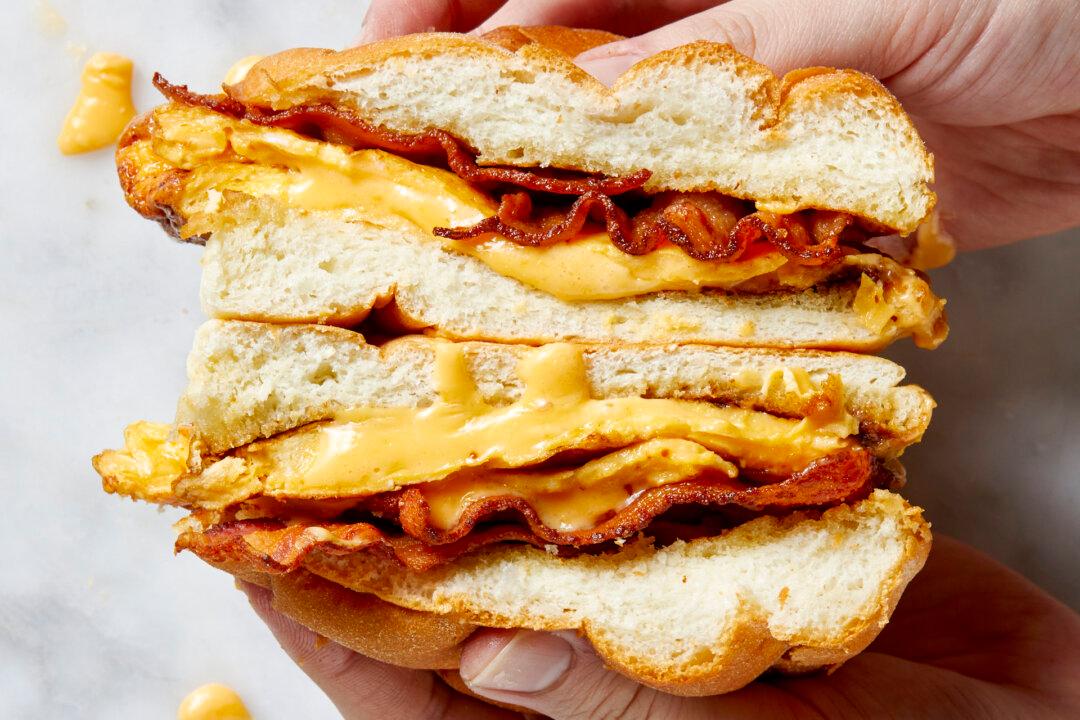If lobster ravioli is on the menu at a restaurant, you better bet I’m ordering it. When I was growing up, it was the ultimate luxury to be able to order my two favorite things in one dish: pasta and lobster. So I was extra excited to develop this recipe. Sure, making ravioli is going to take some time and effort; it’s just the nature of this pillowy filled pasta. But I streamlined the process as much as possible. Just remember that it’s supposed to be fun — and it’s even better if you do it with a buddy.
Ingredient Notes for Lobster Ravioli
The pasta: I started with Kitchn’s go-to homemade pasta recipe. The ratio of eggs to flour is just perfect, and the soft dough is super easy to work with.
The lobster: To make things simpler, I’m not expecting you to cook your own lobster (although you certainly can if you have access to fresh lobster!). Start with whole cooked lobsters and crack the meat yourself, or buy already shelled lobster meat.
The filling: Once you get the lobster ready to go, just add a bit of ricotta, Parmesan, parsley, lemon zest, and garlic. You don’t want too much — lobster reigns supreme.
The sauce: Because I wanted all the time and effort to go into preparing the ravioli, but couldn’t sacrifice not having a great sauce, I used my go-to tomato and wine cream sauce. It comes together in less than 10 minutes and tastes as silky and rich as any long-simmered pasta sauce. And the combo of wine and lobster is richly satisfying. That said, my sauce is not the only way. A buttery garlic sauce, Alfredo, or marinara would suit this dish just as well!
What to Eat With Lobster Ravioli
Lobster ravioli is such a stunning dish that it must be the main attraction on the table. Pick crisp green sides to accompany it (think: steamed broccoli, a simple green salad, or roasted asparagus). A nice, fresh bread like a baguette to sop up extra sauce is clutch. And if you drink white wine, keep the rest of the bottle that you used to cook the sauce on ice to serve alongside dinner.
Tips for Rolling out the Pasta Dough
1. The dough should be super thin. It should almost be transparent.
2. Dust the pasta lightly with flour as needed. This will help to keep it from sticking. You can also lightly dust the machine or rolling pin with flour.
3. Don’t hurry the process. If the pasta is tearing, you are likely moving it through the roller too fast. Slow down and make sure to put it through each thickness a few times before proceeding to the next.
Your Options for Rolling out the Pasta Dough
- KitchenAid pasta attachment: The fastest and easiest way to roll out pasta is using the pasta attachment on a KitchenAid stand mixer.
- Hand roller: A hand roller is going to be the next-best bet for cranking out thin sheets of pasta.
- By hand: If you don’t have either gadget, do it the old-fashioned way. Just be prepared — rolling out pasta with a rolling pin takes a lot of elbow grease.
Your Options for Cutting the Ravioli
No matter which way you choose, these are going to taste and look amazing. The truth is you need very little tools to actually make ravioli, but the more you have, the easier the process.
- For clean edges: An ordinary chef’s knife (or pizza cutter) works for clean edges.
- For fluted edges: Use a fluted-edge pastry cutter. This will give a more rustic look.
- For the most consistent shape: Opt for a ravioli mold. This is my preferred method. (I use a mold my mom got in the ’70s that has stood the test of time!)
Lobster Ravioli
Serves 4 to 6; makes 45 to 50 ravioli
Ingredients- 1 recipe Fresh Pasta Dough (about 1 pound)
- Semolina flour, for pasta rolling
- 1 ounce Parmesan cheese (1/2 cup firmly packed freshly grated or 1/3 cup store-bought grated), plus more for serving
- 1 medium lemon
- 4 cloves garlic
- 3 (about 1-pound) whole cooked lobsters, or 8 to 9 ounces cooked lobster meat
- 3/4 cup whole-milk ricotta cheese (6 ounces)
- 3/4 teaspoon kosher salt, divided, plus more as needed
- 1/4 teaspoon freshly ground black pepper
- 1 small yellow onion
- 2 tablespoons olive oil
- 1/4 cup tomato paste
- 1/2 cup dry white wine
- 1/2 cup heavy cream
- Chopped fresh parsley or basil leaves, for garnish
Roll Out the Pasta Dough
1. Line a baking sheet with parchment paper and generously dust with semolina flour.
2. Cut 1 pound pasta dough into 8 pieces. Roll out the dough one piece at a time (cover the remaining pieces of dough in plastic wrap to keep them from drying out): Set a pasta roller to the thickest setting. Flatten the piece of dough into a thick disk with your hands, dusting with semolina flour if it feels sticky. Feed it through the pasta roller twice. Fold the dough into thirds, like a letter, and press it between your hands again.
3. With the pasta roller still on the widest setting, feed the dough crosswise (folded-side in first) between the rollers. Feed it through once or twice more, until smooth. If desired, repeat this folding step. This helps to strengthen the gluten in the flour, giving it a chewier texture when cooked.
4. Begin changing the settings on the roller to roll the pasta thinner and thinner. Roll the pasta 2 or 3 times at each setting (no need to fold anymore), and don’t skip settings (the pasta tends to snag and warp if you do). If the pasta gets too long to be manageable, lay it on a cutting board and cut it in half crosswise before you continue rolling.
5. Roll until the pasta is very thin and you can see your hand through it (setting 6 on a KitchenAid pasta roller attachment). Sprinkle lightly with semolina flour and lay flat on the baking sheet. Repeat rolling out the remaining pieces of dough, separating the layers of pasta sheets with more parchment paper.
Make the Ravioli Filling and Prep for the Sauce
1. Prepare the following, adding each to the same medium bowl as you complete it: Finely grate the zest of 1 small lemon until you have 1 teaspoon; reserve the zested lemon for another use. Finely grate 1 ounce Parmesan cheese (about 1/2 cup), or measure out 1/3 cup store-bought grated; grate more for serving if desired.
2. Finely chop 4 garlic cloves; add half to the bowl and reserve the remaining for the sauce. Crack and remove the meat from the claws and tails of 3 (about 1 pound) whole cooked lobsters (about 2 cups); discard the shells. Finely chop the meat and add to the bowl.
3. Add 3/4 cup whole-milk ricotta cheese, 1/4 teaspoon of the kosher salt, and 1/4 teaspoon black pepper, and add to the bowl. Stir to combine. Cover and refrigerate until ready to use.
4. Finely chop 1 small yellow onion (about 1 cup) and reserve for the sauce.
Make the Ravioli
1. Line a second baking sheet with parchment paper and sprinkle with semolina flour. Sprinkle a work surface with semolina flour and arrange a pasta sheet on top with a longer side closer to you.
2. If the pasta sheet is at least 4 inches wide from top to bottom, spoon 1 1/2-teaspoon portions of the filling onto the bottom half of the pasta sheet about 1-inch apart. Gently brush a little water around each portion of filling. Starting from one side and working your way to the other, fold the top half of the sheet down and over the filling, pressing out the excess air around each portion of filling as you go and sealing the top and bottom together. If the dough gets sticky at any point, dust generously with semolina.
3. If the pasta sheet is less than 4 inches wide, spoon 1 1/2-teaspoon portions of the filling across the center of the sheet about 1-inch apart. Gently brush a little water around the border of the sheet. Starting from one side and working your way to the other, place a second sheet over the first sheet, pressing out the excess air around each portion of filling as you go and sealing the top and bottom together. If the dough gets sticky at any point, dust generously with semolina.
4. Using a pasta cutter or sharp knife, cut around each portion of filling to form individual raviolo. Don’t worry if they are not perfect — they will still taste great.
5. Transfer the ravioli to the baking sheet in a single layer and repeat filling all the pasta sheets. Gather the pasta scraps, reroll them, and form more ravioli until you run out of filling. You can cut up any remaining pasta scraps and cook them up for a snack. If you don’t plan to cook the ravioli right away, refrigerate uncovered for up to 4 hours. (See Recipe Notes for freezing instructions.)
6. Bring a large pot of heavily salted water to a boil. Add half of the ravioli and cook until the pasta is cooked through and al dente, 4 to 5 minutes. Remove the ravioli with a large slotted spoon or spider to a colander.
7. Repeat cooking the remaining ravioli, but reserve 1 cup of the pasta water before draining.
Make the Sauce
1. Return the now-empty pot to medium heat. Add 2 tablespoons olive oil and heat until shimmering. Add the onion and remaining 1/2 teaspoon kosher salt. Cook, stirring occasionally, until tender, 3 to 5 minutes. Add the reserved garlic and cook, stirring often, until golden and fragrant, about 1 minute. Add 1/4 cup tomato paste and cook, stirring often, until the tomato paste slightly darkens in color, about 1 minute.
2. Add 1/2 cup dry white wine and boil, scraping up the browned bits at the bottom of the pot, until reduced by half, about 1 minute. Add 1/2 cup heavy cream and add 1/2 cup of the reserved pasta water. Bring to a boil. Add the ravioli and toss and cook until the sauce coats the ravioli and they’re heated through, about 2 minutes. If the sauce is too thick, add more of the pasta water as needed. Taste the sauce and season with more kosher salt as needed. Serve garnished with more grated Parmesan and chopped fresh parsley or basil leaves.
Recipe Notes
- The ravioli can be made ahead and frozen uncooked on a baking sheet in a single layer until solid. Transfer to zip top bags and freeze for up to three months. Cook from frozen, adding 1 minute to the cooking time.
- Leftovers can be refrigerated in an airtight container for up to two days.
Copyright 2023 Apartment Therapy. Distributed by Tribune Content Agency, LLC.





